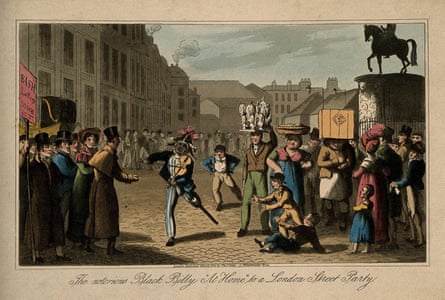Two hundred years ago today, a one-legged Black pauper lay in the infirmary of the St Giles-in-the-Fields workhouse, slowly fading away. It was a sad end to the remarkable life of Billy Waters – the first African American musician to become celebrated in Britain.
Billy, as he was widely known, didn’t perform on any stage. He fiddled, sang and danced as a busker on the streets of London’s West End. It was his sole means of supporting his beloved “Poll” and their two young children. But busking was deemed begging – and illegal. Billy constantly risked arrest, and some months prior to his final sickness he was taken to court and threatened with prison if caught again. Before entering the workhouse he pawned his fiddle.
Billy Waters died on 21 March 1823. In his last years he became a legendary figure, hailed as a genius by writer and dramatist Douglas Jerrold, who had seen him perform. But hard facts about Waters are few, and in their absence he’s remained obscure – his origins unknown save that he was once a sailor.
On the bicentenary of his death, a measure of justice is coming at last to this pioneering Black Londoner. An Early Day Motion tabled in parliament by Bell Ribeiro-Addy, MP for Streatham, recognises Waters’ contribution to popular culture in Britain; and a commemorative plaque by the Nubian Jak Community Trust will be unveiled where he lived in the former St Giles Rookery.

Why has it taken so long for Waters to gain wide recognition? As a roots-music writer, I only came across him by chance a few years ago in Dublin, where I found a striking image of Waters on a collection of minstrel tunes – the only published music with any link to him, almost certainly indirect. Who was this extraordinary looking man? I was intrigued and began researching, reading and listening. The outline of a life started to emerge.
In the National Archives in Kew, the muster-book of the ship he sailed on revealed that William Waters was born in New York during the American revolution; and that in 1811, at the climax of the Napoleonic wars, he enlisted in the Royal Navy as an able seaman – an experienced sailor. At first he was on the supply-ship HMS Namur whose captain was Jane Austen’s brother Charles. Waters then joined the crew of HMS Ganymede, and was soon promoted to quarter gunner, with the rank of petty officer. The 26-gun frigate led a convoy from Portsmouth to Spain; but on the voyage home, while loosening sail aloft he slipped, and plummeted to the deck. The captain noted tersely: “Wm Waters fell from the main yard & broke both his legs, otherwise severely wounded him.” His left leg was amputated below the knee.
Growing up by New York’s waterfront, Billy Waters would have learned how to play fiddle and perform solo dances in dockside taverns and markets. Such agility and entertainment skills were valuable for any young sailor. As a wounded veteran in London he drew on them again to supplement a meagre pension, taking a pitch outside the Adelphi theatre on the Strand.
Thousands of people of all ages saw and heard Waters busking. His hallmark attire – large military-style headgear with feathers, judge’s “cauliflower” wig, tattered naval jacket – was a carnivalesque send-up of British authority. He sang and danced while fiddling and made use of his wooden leg to perform “peculiar antics” – pivoting on it, kicking it out. An engraving, “The Notorious Black Billy at Home to a London Street Party”, shows him in action flanked on one side by well-to-do citizens, on the other by children and tradespeople. A white youth mimics his steps.
Waters played for dancing, without accompaniment, and – since he needed to grab attention and be heard above street-cries and noise – his voice would be loud and penetrating, his bowing was probably rhythmic and vigorous, his touch well-accented and syncopated, his tone droning and scratchy. You can hear something similar in Sid Hemphill’s fiddling, with an echo too in Joe Thompson (1918–2012), the last traditional Black fiddler in North Carolina.
Waters embodied a spirit of lively defiance in dark times. In impoverished St Giles, nicknamed “The Holy Land” for its large Irish-Catholic population, he was a well-loved community musician. Waters and family lived in the notorious St Giles Rookery – a maze of narrow streets and courtyards with damp, dilapidated and horribly overcrowded houses, concealed passages and open sewers just a short distance from the British Museum. At night he played in a public house known as The Beggar’s Opera, the gathering-place of “cadgers”, vagrants, petty thieves, sex workers and street people.

The pub also attracted a few Regency bucks, or swells, who took delight in slumming – among them writer Pierce Egan and caricaturists George and Robert Cruikshank. In Egan’s hugely successful book Life in London, its three swell protagonists – said to be the author and the Cruikshank brothers – pay a visit to a barely disguised Beggar’s Opera. Though not named, Waters is described; and in a key illustration his profile is unmistakable. He became a famous lowlife character, ripe for further exploitation.
Life in London was swiftly adapted for the stage by William Moncrieff as Tom and Jerry, the names of the two principal swells, opening in late 1821 at the Adelphi – Waters’ pitch. In the celebrated Back Slums in the Holy Land scene, former clown Signor Paulo played the role of “Billy Waters” as a disdainful, bullying and ludicrous rogue, the leader of a group of hypocritical beggars. Tom and Jerry ran for a record-breaking 16 months.
This unearned reputation was a far cry from the real Waters, who we know through only two fragments of reported speech. One comes from TL Busby, the artist who created the portrait of Billy. He wrote circa 1820: “[Billy] has a wife, and, to use his own words, ‘one fine girl, five years old’, and is not a little proud to perceive a resemblance in the child to himself.”
The other fragment is from a newspaper account of his appearance at the Sheriff’s Court of Enquiry in Hatton Garden in 1822 – the same courthouse at which the young Oliver Twist would later appear in Charles Dickens’ novel. The magistrate told Waters sternly that he should take up the offer of a room at the navy’s Greenwich hospital, and his wife would be put “in a way to provide for herself” since she wasn’t allowed to join him, adding that if he was caught begging again he would be committed. Waters, however, declared “he would live and die constant to Poll”; and that nothing but force should separate him from her.
The real Waters suffered greatly from Tom and Jerry’s racist defamation, losing his good name and with it his income as a busker, and his very identity. In later life a remorseful Moncrieff wrote that Waters attended a performance and denounced Paulo, only for the audience to turn on Waters and violently eject him. The authorities also turned on him. Two weeks after Tom and Jerry’s opening he was arrested twice on the same day, charged with “begging and collecting crowds in the streets” and “singing immodest songs”. Wounded in spirit, a year later he was gone.
after newsletter promotion
Waters had fired the popular imagination like no other London street performer. A two-penny broadsheet purporting to show his funeral procession ran to at least 13 printings. References continued for decades: an illustration in Henry Mayhew’s London Labour and the London Poor (1851) depicts a young Blackface fiddler dressed as Waters; an article on British minstrelsy recalls him as the subject of “hero-worship”; Victorian shadow-puppet shows featured “Billy Waters the London Fiddler”, and for more than 40 years ceramic figurines of him were made.
Sadly Waters left no music – just one bluesy couplet, with variants, from his signature song:
Polly will you marry me? Polly don’t you cry,
Polly come to bed with me and get a little boy
In 1959, in Mississippi, folk song collectors Alan Lomax and Shirley Collins recorded the octogenarian musician Sid Hemphill playing Polly Will You Marry Me? on homemade banjo. “That’s an o-o-old song,” he adds.
Waters played an important part in the history of popular entertainment in 19th-century Britain, more than a decade before the coming of blackface minstrelsy. He’s the ancestor of buskers, bluesmen, breakdancers, rockers and rappers everywhere – an urban folk hero whose story is resonant still: applauding the installation of the commemorative plaque, Ribeiro-Addy described him as “an inspiration for BAME, disabled and immigrant communities everywhere, and an early herald of the UK’s thriving Black performing arts community”.
Curiously, in certain respects Waters bears comparison with another African American performer well ahead of his time, who also dressed flamboyantly, performed “peculiar antics”, and lived in London’s West End, where he became famous for a few short years and where he died. But Jimi Hendrix died relatively rich; Billy Waters’ body was carried in a flimsy casket from the workhouse to the burial ground by Old St Pancras church, and interred in an unmarked, and unprotected, pauper’s grave.
Though much of Waters’ life remains in the shadows, he’s one of very few early Black performers we know anything about at all. He emerges from the margins of Regency society as an intelligent, skilful, and adventurous professional man, and a fun-loving father and husband. For a while he managed to defy the formidable odds stacked against a disabled Black immigrant. But there was no way to escape his ruthless exploitation.





More Stories
Remembering Roots Musician Steve James 1950–2023
Mark Stewart, Pop Group frontman and revered countercultural musician, dies aged 62 | Music
Musician Hunter Hayes on the cost of fame and anxiety: ‘I’m my hardest critic’